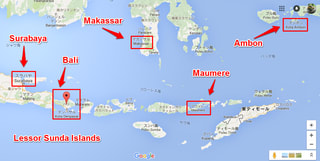In the last article I talked about general issues.
In forming ideas about possible routes it is probably best to talk about individual ports of call for reasons both for and against (mainly historical and to some extent out of geographical reasons), I think.
Only then can we visualise a few of the possiboe routes for actual travel.
With this in mind let us take another closer look at the Pelni map.

First of all, we are not interested in any of the ports west of Surabaya, except Jakarta for embarking purposes. There must be direct flights from Tokyo to both Surabaya and Bali, I think. So, Jakarta and west can be totally neglected.
As I mentioned earlier we are not interested in the Lessor Sunda Islands either between Bali and Maumere, say, because there are non-Pelni ferries along this chain of islands. Here is the relevant map.

This chain of islands, in its own right, is an interesting route and we note with satisfaction that Denpasar and Kupang are major nodal points on this Pelni map.
In particular, we also note with pleasure that it is possibe to go from Maumere to Makassar. This was a missing link on some of other privately edited Pelni maps.
Having said that one island which is of particular interest is Ambon. We can easily single it out because all of the stories in this region started with this island in 1513.
It is also sitting right in the middle of Banda sea.
Ambon 1513
The Portuguese came to this island first in 1513. Then came the British and the Dutch and all the way across the Pacific the Spaniards. In 1623 there was a historically famous massacre on this island.
The Dutch beheaded 10 British merchants, 9 Japanese mercenary soldiers and a large number of locals and one Portuguese after torturing them by fire and amputating their legs.
Consequently, everybody got so pissed off at the Dutch atrocity and the British went away and concentrated on colonising India. The Spaniards went further north to the Phyls. The Portuguese retrieted to South America. The Japanese also went away and closed its borders.
The Dutch therefore thrived in this region of present day Indonesia for the next 300 years until they were eventually driven out by the Japanese.
So, this is a very interesting area to visit.
Ternate
By 13th century there had been a long standing and well established Islamic kingdom around Ternate before a Portuguese ship got shipwrecked there and sailors were all rescued and well looked after by the locals.
Just like the Turkish navy ship shipwrecked off the coast of Nagoya in 19th century Japan. The only difference being that the Portuguese in return quickly decided to colonise this kingdom. In so doing they were forced to killing a very large number of locals indeed. They were eventually driven out, all thanks to the Dutch, however.
That is all histroy, what we call histroy, though.

Where do we go from here?
My gut feeling is that rather than forming out a route of your own making we might just as well look at some of the existing Pelni routes and see how well or not well they might fit with what you are potentially interested in.
At Pelni they have about 25 liners and consequently there are about 25 ready-made routes to consider. So, in the next article we will be looking at some of them for scrutiny.















 My gut feeling is that it is Davao that you should come to if you are flying into the Phyls.
My gut feeling is that it is Davao that you should come to if you are flying into the Phyls. Here, we see that the town centre of Gensan (General Santos, locally) is away from the warf area by quite a distance, something like 5 km.
Here, we see that the town centre of Gensan (General Santos, locally) is away from the warf area by quite a distance, something like 5 km. That an airport is there is somewhat reassuring, even if it may be an air strip.
That an airport is there is somewhat reassuring, even if it may be an air strip. Let us have a loo at a satellite pictures.
Let us have a loo at a satellite pictures. What we can see here is that both EPA and Eaga Agro Marine we have been talking about have very large buildings.
What we can see here is that both EPA and Eaga Agro Marine we have been talking about have very large buildings.

 This last image is showing us the location of the Philippine Ports Authority and in particular the entrance gates to PPA.
This last image is showing us the location of the Philippine Ports Authority and in particular the entrance gates to PPA. This is what the gates area looks like. You go in and turn left then you will see the PPT building.
This is what the gates area looks like. You go in and turn left then you will see the PPT building.
 This is the major junction, not terribly important on its own, though.
This is the major junction, not terribly important on its own, though. There is an Immigration office at the Robinsons. Satellite photo is next.
There is an Immigration office at the Robinsons. Satellite photo is next.

